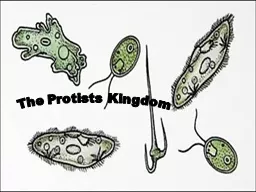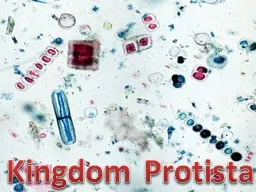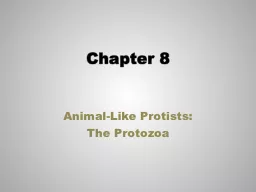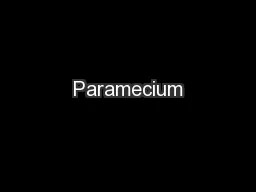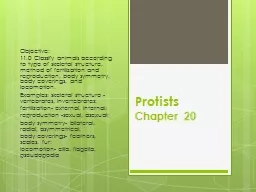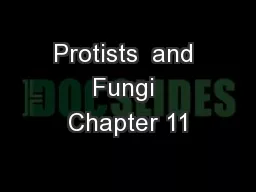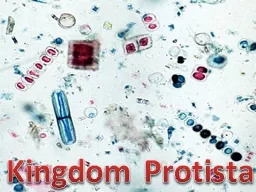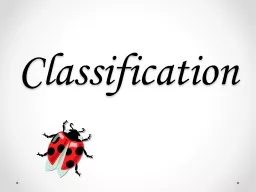PPT-The Protists Kingdom
Author : celsa-spraggs | Published Date : 2017-09-14
What Are Protists A group of onecelled organisms with well defined nuclei All protists live in moist surroundings Many protists possess both plantlike and animallike
Presentation Embed Code
Download Presentation
Download Presentation The PPT/PDF document "The Protists Kingdom" is the property of its rightful owner. Permission is granted to download and print the materials on this website for personal, non-commercial use only, and to display it on your personal computer provided you do not modify the materials and that you retain all copyright notices contained in the materials. By downloading content from our website, you accept the terms of this agreement.
The Protists Kingdom: Transcript
What Are Protists A group of onecelled organisms with well defined nuclei All protists live in moist surroundings Many protists possess both plantlike and animallike features Animal like protists are called PROTOZOAN . Life Science – January 2013- Hooper. What is a Protist?. Protists. are eukaryotes (organisms whose cells have a nucleus). that cannot be classified as plants, animals, or fungi.. Additionally, all protists live in moist surroundings.. Unicellular Organisms. Some organisms are made up of only . one cell. .. We call these organisms . unicellular. which means one-celled.. These organisms are much . simpler. than most organisms that are made up of many cells.. Protists. Pgs. . 2. 15 - 220. Animal-like Protists. One-celled animal-like protists are called protozoans. They are classified by how they move. All of these organisms eat other organisms.. Ciliates. Any organism not classified as a—. plant. , . animal. , . fungus. , or . bacteria. (prokaryote).. Protists are . eukaryotic. having a distinct nucleus and organelles.. Most . protists. are . unicellular. Animal-Like Protists:. The Protozoa. Evolutionary Perspective of the Protists. The protists are a polyphyletic group that arose about 1.5 billion years ago when the Archaea and Eukarya diverged.. Our understanding of the evolutionary relationships among protists is currently in flux . By: Joanna, Kyla, and Larissa. What is a . Protist. ?. Single or multiple cell eukaryotic organisms with an enclosed nucleus that cannot be . classified . as an animal, fungi or plant. Animal-Like . Protists. & Amoeba. SWBAT observe . paramecium and amoeba and . understand their unique biological functions. Bacteria are microscopic single-celled organisms that thrive in diverse environments. They can live within soil, in the ocean and inside the human gut. Humans' relationship with bacteria is complex. Sometimes they lend a helping hand, by curdling milk into yogurt, or helping with our digestion. At other times they are destructive, causing diseases like pneumonia. . Have 1 . BLANK . sheet of paper on your desk. Pencil or pen to write with. Cellphones should be in your bag. Voices off, ready to learn. Protists. Protists. Protists. are eukaryotes that can not be classified as animals, plants or fungi.. 11.0 Classify animals according to type of skeletal structure, method of fertilization and reproduction, body symmetry, body coverings, and locomotion.. Examples: skeletal structure -vertebrates, invertebrates;. What is a . p. rotist. ?. Use your Guided Notes handout with this slideshow.. Protist. —an organism . from the Kingdom . Protista. Very . diverse. group of single-celled organisms.. Eukaryotic . (They have . P. . Lobosco. Monday November 8, 2010. There will be no grades given out until this Friday. Please do not ask!. HW-Read 11-1 and do the section review on page 273, questions 1-10 due Wed. Use spiral notebook.. plant. , . animal. , . fungus. , or . bacteria. (prokaryote).. Protists are . eukaryotic. having a distinct nucleus and organelles.. Most . protists. are . unicellular. (one-celled) but some are . ). Protists. are….. organisms that cannot be classified into any other group (plant, animal, fungus, bacteria). o. rganisms that are typically made up of just one cell. o. rganisms that can be made up of many cells. Standards. GSE S7L1: Obtain, evaluate, and communicate information to investigate the diversity of living organisms and how they can be compared scientifically.. GSE 7L1b: Evaluate historical models of how organisms were classified based on physical characteristics how that led to the six-kingdom system (currently archaea, bacteria, protists, fungi, plants and animals).
Download Document
Here is the link to download the presentation.
"The Protists Kingdom"The content belongs to its owner. You may download and print it for personal use, without modification, and keep all copyright notices. By downloading, you agree to these terms.
Related Documents

